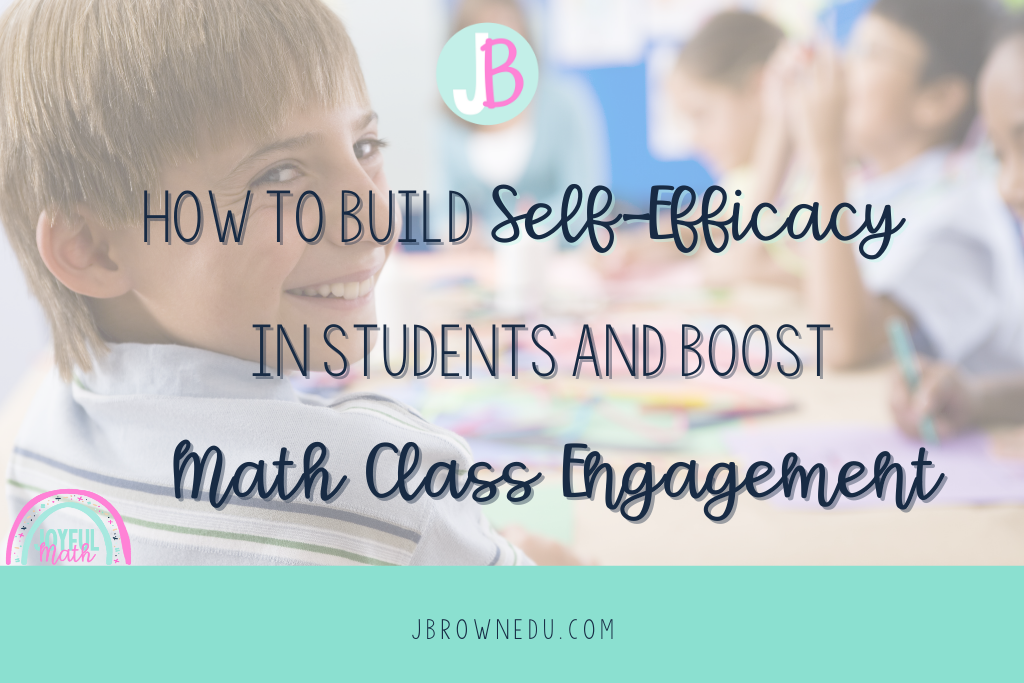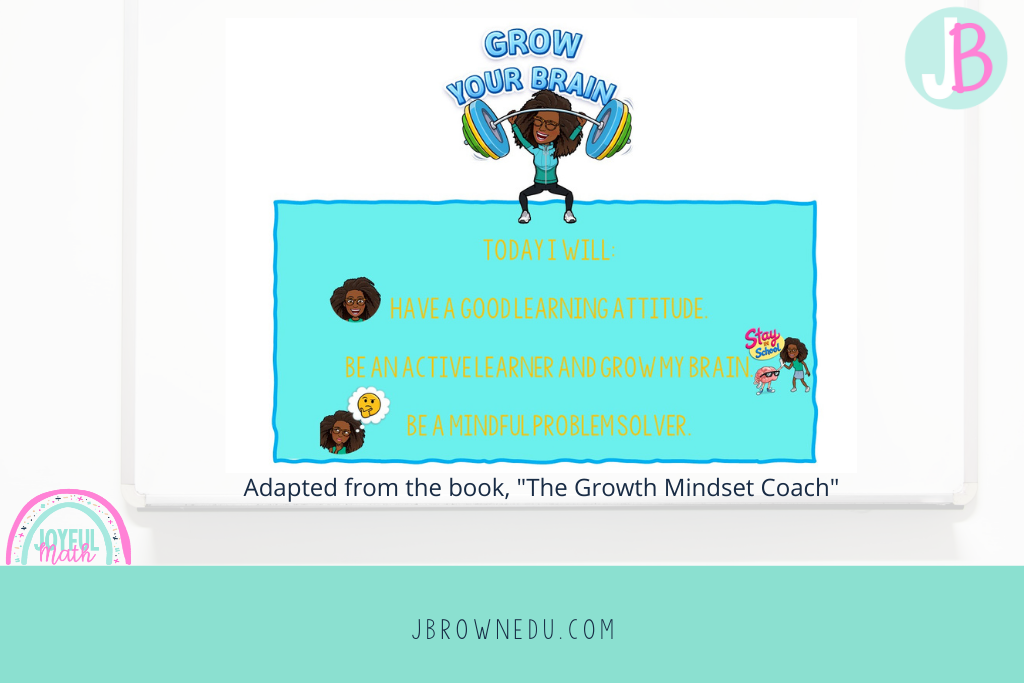“I’m afraid to go to 1st grade because the tests will be timed and I’m afraid I won’t get the answers right.” This is a response that I received from a first grader about if he was ready for the new school year to begin. I was so disheartened. The start of a new grade should be exciting, an accomplishment to celebrate. Why is this student so afraid? He simply doesn’t believe that he has what it takes to succeed. It breaks my heart that students deal with math anxiety caused by a lack of self-efficacy in as low as first grade. So what do we do to remedy this? We develop and build self-efficacy in students.

What is self-efficacy?
Bandura defines self-efficacy as “people’s judgments of their capabilities to organize and execute courses of action required to attain designated types of performances.” So for students, this would look like a student’s thoughts about if they are capable of completing the task or not. We often hear “crickets” in math class because students are so paralyzed by fear, worrying about if they are capable enough to give an answer that their teacher and classmates will be pleased with.
Importance of self-efficacy in students
John Hattie is one of my absolute favorite researchers. In his study on influences that affect student achievement, self-efficacy was in the top 15 out of 252 influences on a study of what works best in education. Whoa! That says a lot about the decisions that we make in our classrooms. This tells me that if I want to see student engagement and achievement, I better focus on self-efficacy first. It ranked higher than classroom discussions and even scaffolding. You can view the chart on this site. If students have a high self-efficacy this will lead to more engagement, which will then lead to increased academic achievement.

Developing self-efficacy in students
This development phase takes a while. The important factor is to be consistent with the process. For every 1 negative comment we hear, we need to hear 5 positive comments to offset it. Think about the negative mindsets that students are already coming to you with. There’s already a deficit of positive comments to make up for. So how do we practically work to develop self-efficacy in students? Let’s start here:
1. Cultivate a Growth Mindset Culture where it’s ok to make mistakes, through using monthly mindset quotes and a growth mindset pledge.
It is imperative that the classroom environment is a positive one, where everyone has a growth mindset and is ok with making mistakes. A growth mindset can’t be tackled with just one activity at the beginning of the school year to never be visited again. It has to be engrained in students. One way that I do this is to have a monthly growth mindset quote and this gets embedded throughout the lesson. When the quote is first introduced, we talk about the importance of it and how it can help us.
For example, a quote by Einstein says,
“It’s not that I’m so smart, I just stay with the problem longer.”
-Albert Einstein
We read the quote each morning, students answer a morning question about it, and they are constantly encouraged throughout the lesson with the quote. While students are working independently and may encounter a struggle that they want to give up on, I encourage them to be an Einstein and stick with it. This changes their mindset about the idea of being “smart” and having to know the answer so quickly.
It’s really like they are being coached through the process. If you’d like to check out the format of this, here’s a free copy to get you started using this in your class right away. If you want an entire school year’s worth of quotes on morning slides with SEL check-in, posters, student questions, bookmarks, and a parent note, you can access that here. So much goodness already packaged for you.
We also do a growth pledge at the beginning of EVERY single class: “Today I will…have a good learning attitude, be an active learner and grow my brain, and be a mindful problem solver.” This sets the tone that we aren’t looking for perfection from each other. This pledge was derived from the book, “The Growth Mindset Coach.” It’s such an amazing tool to have for creating a growth mindset culture where students are absolutely okay with making mistakes.
My students know that if they aren’t making mistakes, their brains aren’t growing. They became obsessed with the phrase, “grow your brain.” It became something that they looked forward to each day. They even began encouraging each other if someone was hesitant to participate. Or if someone would make a mistake, they would celebrate and say, “Yes! I just grew my brain.” I even grew my brain daily. They saw me mess up every class and I would just say, “See, even Mrs. Brown’s brain is still growing.”

2. Provide Specific Feedback
Students with low self-efficacy need to know exactly what they are doing well at so that they can continue to do it. If someone tells you that you look great today, you will wonder exactly what looked great. However, if they say they love the way that you curled your hair today, you know the exact component to repeat again. It works the same with students.
When you see students working independently, provide feedback on parts that they are doing really well on. It could be as simple as, “Michelle, I love how you drew a place value chart to use a strategy for this problem.” This will encourage Michelle to use the place value chart each time, but now you can call on Michelle to share out with the class the strategy that she used. She may not have solved the problem 100% correctly, however, praise her for the chart and then ask if it’s ok for the class to work on the problem together. Because you’ve already created a positive, growth mindset culture, students are ok with receiving help from their peers. My students have expressed that their favorite, most helpful part of math class, has been when their work is placed on the board for their classmates to provide feedback.
3. Provide Scaffolded Supports
For students who suffer from math anxiety and have low self-efficacy, scaffolded supports are a huge relief. When the anxiety hits them, part of their brain begins to shut down and they can’t take in information. Two scaffolded supports that I like to use in my class are success criteria and anchor charts. After we’ve discussed and solved a problem together as a class, we go back and think about what thinking took place for us to solve the problem. If it’s a conceptual standard, we go through the thinking of the strategy that was used and write it down in steps.
This has brought so much relief to students with low self-efficacy. It helps them to ground themselves and they are more confident when it’s mapped out in front of them. The same concept works for anchor charts and it functions the same way. Students know where they are in the process and feel more equipped to engage and participate. I taught virtually for 2 years so I have used digital and paper copies of anchor charts. You can view the ones that I used here. You can also check out this blog on how to use pre-made anchor charts so that you are still creating them with your students in a meaningful way.
4. Make it Relevant
If you really want to give students something to run home and tell momma about, make a lesson relevant. When I did Star Wars-themed lessons, students were raving about it at home and I received emails from parents thanking me. I noticed participation in class from students that I hadn’t heard from all year. The same happened when I did an Among Us-themed lesson. Depending on the theme, I would see a different group of students be more interested in the lesson. Try rotating themes. Even if you have to teach a set curriculum, just changing the background of your lesson slides can make a difference and pique their interest. Keep it interesting and switch it up often.
Cultural relevance is also a large component of piquing students’ interests. My friend Jocelynn, has incredible resources on cultural relevance. Here’s one that I suggest checking out.

Are you thinking you’d like to try using motivational quotes and agenda slides for FREE before committing to it? I totally understand. You want to make sure that your students are really going to buy into it before you spend your coins on it. This is exactly why I decided to take a portion of my Activities for Social-Emotional Learning packet and gift it to you! Enneagram wing 1, coming through! Gift-giving is my love language. Get your free startup kit below. This will help decrease your students’ math anxiety, build their self-efficacy, and increase student achievement. Your students and their parents will thank you!
Want to check out some other ways to engage students in your math class? Check these out:
http://jamiemillermath.com/creating-classroom-norms/
https://mathwithmsmatherson.com/collaborative-groups-in-math-class/
https://thehappylittleclassroom.com/2021/08/06/get-to-know-your-students-as-mathematicians/



[…] Groups in Math Class How To Build Self-Efficacy in Students and Boost Math Class Engagement Please follow and like us: classroom normsclassroom values By jamiemillermath 0 […]